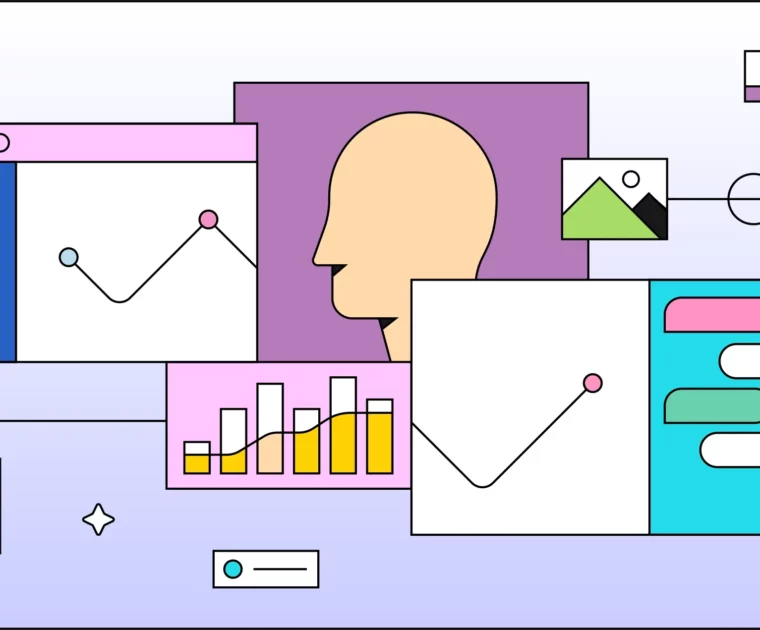Vanity Metrics: The Shady Side of Influencer Marketing (and Why Big Brands Are Finally Calling BS on the Whole Industry)
Last Updated September 2018
“Vanity metrics” is a term that comes up pretty often in the context of influencer marketing, typically referring to metrics like follower counts and blog traffic.
Vanity metrics, by definition, are meant to increase the PERCEIVED value of a blog or social influencer by presenting influencer stats that make that influencer more appealing to brands. If their follower count is high, but engagement levels are low, bloggers might direct attention over to their follower count because that particular stat makes them look really valuable. Unfortunately they might be neglecting to mention the fact that they have very low engagement.
We run The Shelf, an influencer marketing platform, so literally every single day we talk brands who are basing their entire outreach strategies on these types of vanity metrics…and getting nowhere.

At first, it surprised me that so many brands put so much weight on metrics like follower counts, as it’s pretty common knowledge that follower counts are easy to inflate. People can go on Fiverr right now and buy 5,000 Twitter followers for a few bucks… or if you’re dealing with a “set it and forget it” type of person who’s in it for the long haul, there are services that will consistently grow an influencers following with bots, cloned accounts, fake accounts, and dummy accounts for a hundred bucks a month or less.
But the influencer rarely retains their newly-purchased follower numbers… and fake accounts don’t offer great engagement, so… there’s that little piece.
While most people know that it’s possible to buy followers, I don’t think that everyone knows that these shady practices have been going on for years.
So, that’s what this post is about. I’ll be covering:
- Why dishonest metrics (we call it influencer fraud ‘round these parts) have become so prevalent within influencer marketing
- Which metrics bloggers and influencers are easily able to manipulate
- The signals marketers should analyze INSTEAD of these tired little vanity metrics
Why Dishonest Metrics (i.e. Influencer Fraud) Became the Thing
Influencers have all realized that popularity – whether real or fabricated – is often the first signal of an influencer’s potential value to brands. If you have craploads of followers (is craploads supposed to be hyphenated?), brands are far more willing to stuff money into your expensive little pockets.
…And if you don’t, they won’t. Simple.
This preoccupation that brands and marketers have with popularity (i.e. follower count) presents bloggers and wannabe brand ambassadors with a moral dilemma:
1. They can grow their following the hard way by networking, sucking up, and publishing years worth of quality content (without getting paid a dime)…all with the hope that one day their hard work will pay off, and they will finally know what it feels like to achieve that true, unadulterated state of popularity that they so long for…
OR
2. They can simply BUY their popularity for five or fifty bucks (depending on how much popularity they want and how legit they want that popularity to look), and rocket-launch themselves into the company of influencers who get the big contracts, the pretty photo ops, and the free stuff.
I’m going to be a sweetheart and say that most influencers probably start out with noble intentions, but after struggling for enough time, as well as watching other, less qualified influencers zoom past them for the price of 5 dollars worth of followers, many of them start to venture into the vanity metric gray-zone.
There are a few social media users who will leap head-first off of their moral high-ground, and flat-out purchase their followers, traffic, YouTube views, etc…Meanwhile, others will utilize less extreme tactics that are more like shortcuts instead of outright cheating.
Regardless of the intentions behind these tactics, by inflating their numbers these influencers are engaging in deceptive practices and making it a total nightmare for marketers to find the RIGHT influencers for their campaigns.
The flip side is if brands and marketers weren’t bent on finding a quick fix for the Instagram puzzle, this particular “influencer black market” would never have emerged.
So, I can totally empathize with the brands who have to navigate through this mess… and I can totally empathize with the plight of the influencers.
Whether or not you feel influencers are justified in manipulating their metrics, it’s a real issue for brands.
2018 was bang-up year for influencer marketing.
- Influencer marketing is largely responsible for making Kylie Jenner one of the world’s youngest billionaires…
- It also attracted enough negative press this year to make people totally sick of it, and make brands call out influencers who are buying their followers (I’m specifically thinking about Unilever’s dramatic announcement at Cannes)…
- The UAE required influencers to become licensed publishers, and at a pretty hefty price tag…
- The FTC refined its Endorsement Guidelines and got rid of a lot of the loopholes and trap doors…
From the outside looking in, it could be easy to assume all these changes were signs influencer marketing was dying.
But dying and maturing are two different things. If you’re doing influencer marketing and you’ve been using vanity metrics as your go-to, you need a new way of evaluating influencers and measuring the ROI of campaigns.
So, we’re going to tell you which signals matter.
Here’s How to ID Legit Influencers Using Data (you know us)
When I went on Google and started typing in “buy Twitter…” check out what auto-populated. Clearly I’m not the first person to be typing in this search query. If you click through Google’s search results, you’ll be confronted with literally thousands of companies selling followers!
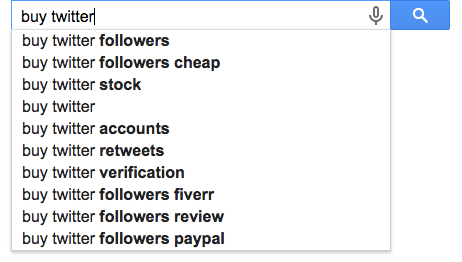
Right around the time influencer marketing really took hold of social media and blossomed into it’s own cottage industry, search volume for terms “buying followers” began shooting up, with Instagram being significantly higher than the other social networks.
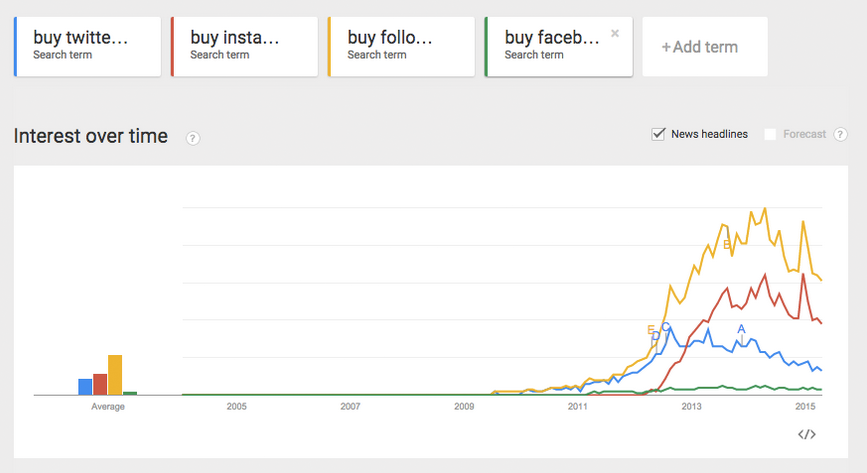
Back then, to gauge the real demand for fake followers, I checked out Google’s Keyword Research Tool, which reported that there were more than 100K searches per month for the various types of follower-buying.
Perhaps that number doesn’t sound super high. But, Google’s Keyword Tool typically underestimates search volume so I included a search for “cat videos” in the screenshot below just so you can see how the numbers compare to something as widespread as the various cat memes that are ransacking the internet. You can see that there are more people looking to buy Instagram and Twitter followers (combined) than there are people searching for “cat videos”!
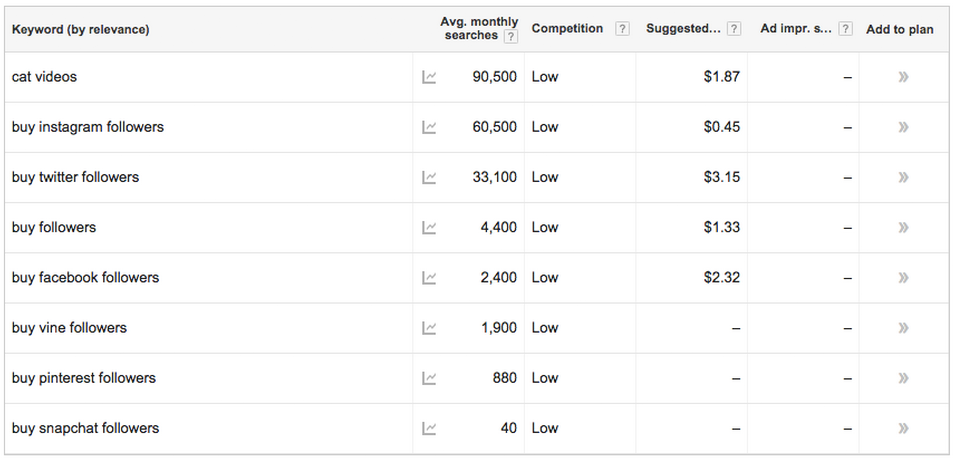
One more thing to note here is how much higher Instagram searches are compared to Twitter, Facebook, and Pinterest. Instagram is by far leading the race in buying followers. And the fact that it’s still that much further ahead than the rest is impressive, considering the frequency with which platforms like Instagram and Twitter go through and purge fake accounts.
As I mentioned earlier, anyone who engages in this tactic has their own reason for it. And in most cases, I don’t think it’s to manipulate anyone. Oftentimes, these bloggers bring in extremely good ROIs for the brands they work with, yet they’re getting paid paltry amounts because they aren’t gaming their follower counts like everyone else.
- This article, written by Kristen, the blogger behind Just K, walks her readers through her various adventures with buying followers. She’s done quite a few experiments and actually wound up getting hit by Instagram’s big cleanup. Her take is an interesting one, and it also explains the rationale for follower-buying from a blogger’s perspective.
- You might also want to check out this post written by Gilad Lotan, a data scientist who blogs about social data. He did an experiment with buying followers and explained the various positive effects that he experienced as a result of that one large jump in his follower count.
Just for fun, go onto Fiverr and look for “Instagram followers” or “Twitter followers”. You have to click around a little because I think they try to prevent people from using the phrase “buy followers”…but you’ll see all sorts of posts that say: “I will 2500 FACEBOOK Likes” or “I will 3000 Instagram followers”. It’s crazy how much clout 5 bucks can buy you!
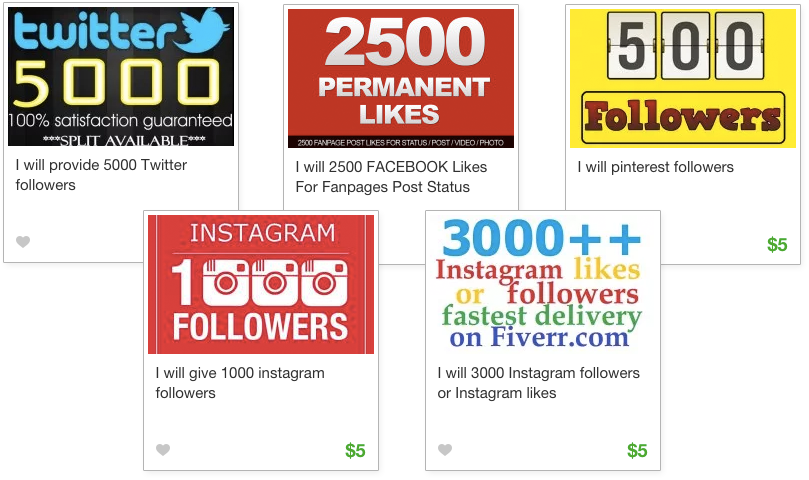
Obviously that sort of thing isn’t allowed by the various social networks, so they’ll up their ante from time to time in order to discourage that behavior.
Without fail, crackdowns by social media platforms will typically affect everyone. Some are affected WAY more than others but almost everyone on Instagram has fake followers, whether knowingly or not. So purges cause dips in everyone’s numbers. The people who had abnormally large percentages of their followers dropping off are the ones you’ll want to be a little of.
On our platform, The Shelf, we have tools that help with this quite a bit. We track follower counts over time and plot each social network on a graph. So it’s helpful to see what’s going on before you reach out to someone about a collaboration. When the Instagram cleanup happened, we noticed that quite a few people had huge dips in their follower counts.
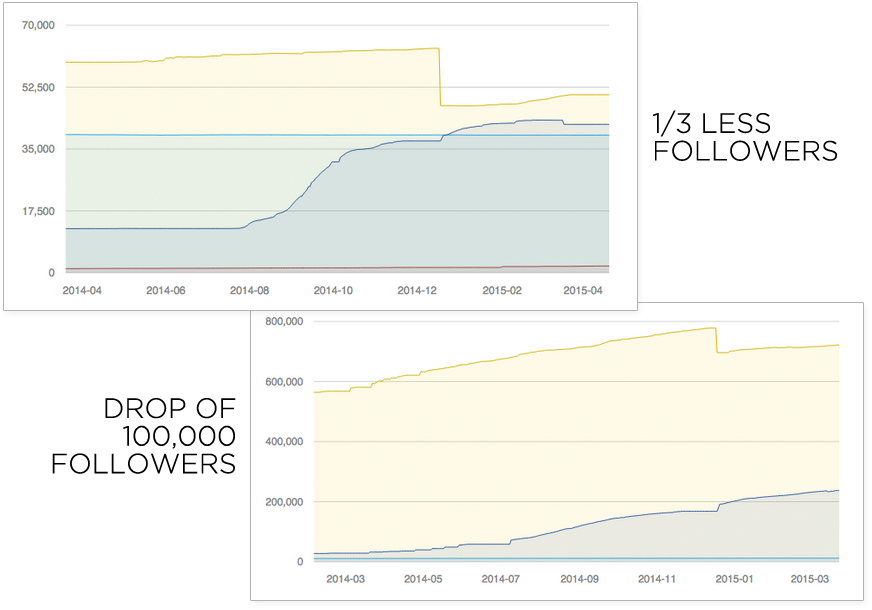
In the above examples, you can see where Instagram made it’s fake-follower-sweep and removed all the fake followers. Our charts can also show you where there are extremely abnormal growth patterns.
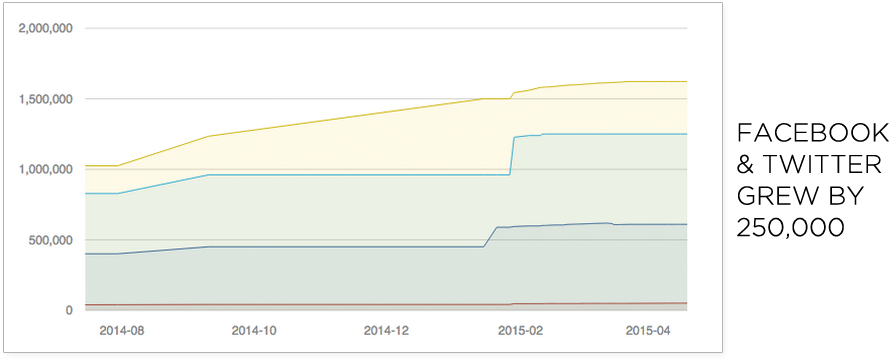
For this person, their Instagram was growing at a nice steady rate, but Facebook and Twitter were lagging behind. It looks like they purchased followers for both Twitter and Facebook on the same day in order to get their growth rate up near their Instagram’s. And while the jump doesn’t look huge, this influencer’s social accounts grew by around 500,000 total followers that day!
Below are two separate Pinterest influencers that seem to be up to something too. I can’t really say definitively that they’re buying followers but growing by 700,000 followers within a few months seems sort of unlikely, especially with such abnormal spurts AND considering they both started down near zero.

Anyway, there are countless ways and reasons why influencers buy followers. Regardless of the measures that these social networks are taking to prevent this kind of behavior, it’s a practice that is here to stay. Where there’s a will, there’s a way, and as long as follower counts determine the worth of people, there will be people trying to game their follower counts.
PURCHASING ENGAGEMENT
This one was actually news to me. When I was on Fiverr, doing research on how to buy followers, I saw that there were just as many people who were selling social network ENGAGEMENT. You can get people to retweet your tweets, Like your Facebook posts, pin your Pins, like your Instagram photos, and comment on any of your posts across your social networks. You can even buy views for your YouTube videos!!!
I thought that it would be difficult to fake YouTube views but evidently bots are out there doing all sorts of nonsense. And it isn’t just the randos out there who are purchasing followers and engagement…even Justin Bieber has been rumored to play in this space.
$5 GETS YOU 5 (QUALITY) BLOG COMMENTS
Discovering sellers on Fiverr who are selling blog comments was actually a little depressing. I assumed blog comments were safe from this but evidently you need to be wary of blog comments as well.
I would ALSO think that fake comments would be easy enough to notice if you take the time to read through some of the comments but if an influencer opts to pay a little more for said comments, those comments will actually be of higher quality, making them harder to detect. Five for $5 will get you quality comments, as opposed to the normal going rate of 15 comments for 5 bucks, which will earn you low quality comments.
TRAFFIC SCAMS
I was already aware that it’s possible to send fake traffic to your site but I was always under the impression that it required the help of a developer. Evidently you can take care of this too for the meager price of 5 dollars…
Here’s an article on the Observer that talks about this happening to a very extreme extent, where publishers were scamming ad buyers out of millions of dollars by using fake “bot” traffic. This isn’t at all what most influencers are doing, but it shows just how widespread this issue is.
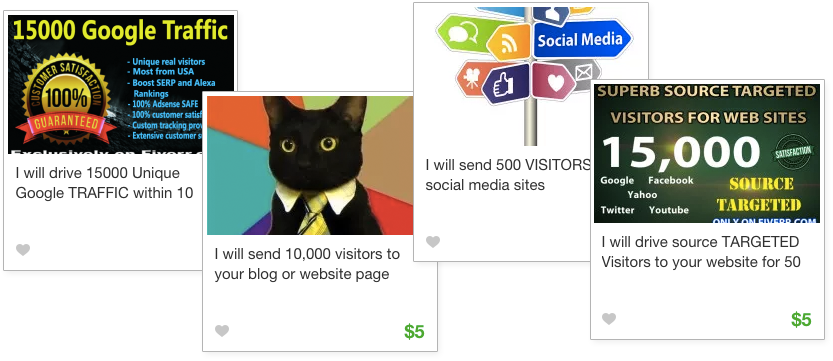
All of the above tactics are straight-up breaking the Terms of Services for these social networks, and even more than that, they’re eroding the trust that brands have with influencers as a whole.
I’m sure that a large percentage of influencers are not frequent Fiverr shoppers but it’s always good to be aware of the options that are out there so that you know what to look for when finding the right influencers to work with. My exploration into the seedy underbelly of Fiverr was actually quite enlightening, so hopefully you were able to learn from all of that as well!
Moving on, we’ll now cover vanity metrics that are less “illegal” than those covered above.
How Influencers to Inflate Metrics Without Breaking Laws
The world of buying followers isn’t completely unmoderated. Many influencers have seen their fake followers removed, and in more extreme cases, their accounts deleted because social networks have built-in mechanisms to prevent abuse. For many, the possibility of having their account deleted is enough to stop them from buying followers and/or engagement.
But there’s more than one way to skin a cat.
First, there’s the age-old Follow/Unfollow technique, one thats been rocked by some of the most “popular” people out there. It involves following a whole bunch of targeted Twitter users, and then several days later, unfollowing the ones who didn’t follow back. A tool that’s popular for this is Unfollowers.com.
This technique will definitely kick the follower counts up for the influencers who go this route, but it does cause the follower/following ratio to get out of whack. In an ideal world, popular bloggers will have a ratio similar to that of Justin Beiber and his massive following of Beliebers (most of whom HE is not following back). Being popular just isn’t as cool if you “like” as many people as those who “like” you. You need to be snubbing a large enough percentage of those people in order for it to be legit popularity.
So for the influencers who are concerned about their ratio, it just requires a small adjustment to the follow-unfollower strategy. Rather than unfollowing the people who don’t wind up following back, they just unfollow everyone, including the people who were nice enough to follow back.
Another mechanism for growing followers without breaking rules is through the use of auto-engagement tools, where an influencer can auto-engage with certain hashtags. In return, those people who received the engagement will typically follow back or reciprocate.
There are many ways to speed up the growth of a social following. Some involve tools. Some just involve focused effort. And…how does one even define foul-play here? Followers don’t just materialize out of thin air, so a certain amount of effort is going to go into growing one’s follower count.
Conclusion
This is the first post in a series of three on the topic of Vanity Metrics. Hopefully it gave you a nice overview of everything that’s possible in terms of the manipulation of an influencer’s metrics. It should also arm you with the knowledge of what to look out for when choosing influencers to work with.
The second post in this group discusses which bloggers will have accurate Alexa/Compete rankings and which ones won’t, plus why. We did a whole bunch of experiments, so you can read all about that here.
The third post will bring everything to a close. Now that you know what to watch out for, and what metrics to avoid when finding your influencers, you now need to know how you should go about picking your influencers if you don’t have stats like follower counts and traffic to base your decisions on. The third post covers all of that, so stay tuned!




